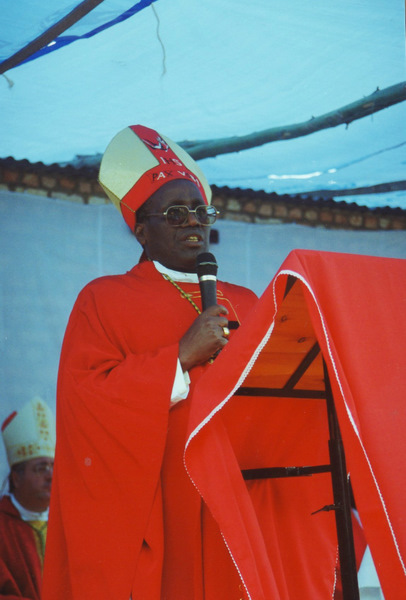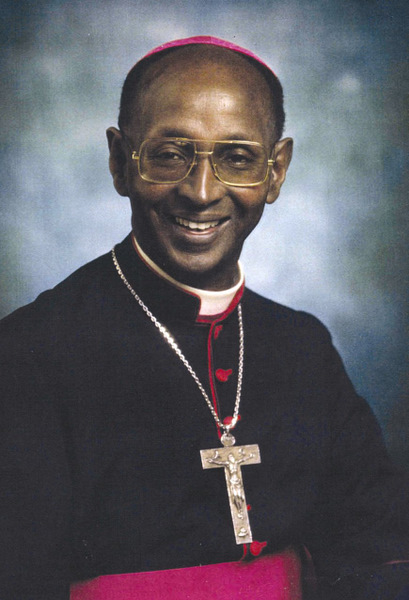Apparitions of the Blessed Virgin Mary at Kibeho Approval
 As the history of the apparitions throughout the world shows, it may happen that the situation after the approval of such a public worship develops in a way that dissuades the church authorities from keeping moving. This, however, is not the case in Kibeho. There are, indeed, enough elements that enable the authorities to assess the events of the apparitions and finally end the debates by a declaration bearing the final judgment on the investigated issues.
As the history of the apparitions throughout the world shows, it may happen that the situation after the approval of such a public worship develops in a way that dissuades the church authorities from keeping moving. This, however, is not the case in Kibeho. There are, indeed, enough elements that enable the authorities to assess the events of the apparitions and finally end the debates by a declaration bearing the final judgment on the investigated issues.
The progress of the work of the ad hoc commissions, at work since March 1982, now offers favourable conditions for this step. This is why the Bishop of Gikongoro thought the wake of the Great Jubilee of 2000 years of redemption and the centenary of evangelisation in Rwanda to be the perfect moment in time to finally close the dossier of the apparitions of Kibeho after 20 years of investigation and thus clarify the situation.
After extensive consultations with his investigation commissions, having also consulted the Holy See and the Episcopal Conference of Rwanda, the Bishop of Gikongoro issued the decree on the apparitions on June 29th, 2001 during a solemn mass concelebrated in the Cathedral of Gikongoro. This decisive act in the history of the apparitions of Kibeho took place in the presence of the Apostolic Nuncio of Rwanda, all members of the Episcopal Conference of Rwanda, many priests from different dioceses of the country, major superiors of various religious communities and lay people from all over the world.
From the long list of supposed visionaries reported at Kibeho over the years, the Bishop retained only three as authentic.
The Bishop declared as follows:
- Yes, the Virgin Mary appeared at Kibeho on November 28th, 1981 and in the months that followed. There are more reasons to believe in the apparitions than to deny them. Only the three initial testimonies merit being considered authentic; they were given by Alphonsine Mumureke, Nathalie Mukamazimpaka, and by Marie Claire Mukangango. The Virgin appeared to them with the name "Nyina wa Jambo", that is "Mother of the Word", which is synonymous to "Umubyeyl W'iamna" that is, "Mother of God", as she herself explained. The visionaries said to have seen her sometimes with joined hands, sometimes with outstretched arms.
- Various reasons justify the choice by Our Lady of these three visionaries already approved as visionaries. These witnesses, historically linked, were the only ones on the scene for some months, at least up to June 1982. They are the ones who made Kibeho known as a place of apparitions and pilgrimage causing crowds of people to flock there.What is more important is that Alphonsine, Nathalie and Marie Claire corresponded satisfactorily to all the criteria established by the Church in the matter of private apparitions and revelations. In contrast, the evolution of the alleged subsequent visionaries, especially after the apparitions were over, reflects disquieting personal situations, which have reinforced the existing reservations in regard to them and discouraged ecclesiastical authorities from proposing them to the faithful as points of reference.
- In the evaluation of the facts and the messages, only the public apparitions are taken into consideration. Public are those apparitions that take place in the presence of various testimonies, which does not necessarily mean a crowd. The most active period of these apparitions ended with the year 1983. Everything said or done after that date at Kibeho did not bring anything new with respect to what was already known, from the point of view of the messages and of the signs of credibility. This is also valid for Alphonsine who continued to attract many people up to the end of her apparitions.
- The first two years of the apparitions at Kibeho (1982 and 1983) constitute a decisive period for whoever wishes to know what happened and form an opinion, since the significant events that made people talk about Kibeho and visit the place occurred during that very period of time. It was always in that period that the fundamental elements of the message of Kibeho were communicated and recapitulated and the apparitions of the major part of the first visionaries ended.
- In the case of the three visionaries named above, who are at the origin of the fame of Kibeho, nothing that they said or did during the apparitions is contrary to Christian faith and morals. Their message is in conformity with the Sacred Scripture and the living Tradition of the Church.
- Since the visionaries were not isolated from their surroundings, external influence or manipulation is possible and has to be considered in the context of the apparitions. Although practically inevitable and difficult to discern, interference of this kind seem not to have altered the true message of Kibeho. The mature analysis of the beginning of the apparitions enables us to extract the messages that the Blessed Virgin Mary really communicated, like the message of the chapel, from the plenty of words attributed to her. The latter should help in our search for the way of the truth that God our Creator, “who wants all men to be saved and to come to a knowledge of the truth" (1Tim 2,4) uses as “subtext” to carry out his plan of salvation.
- Among the signs for the credibility of the apparitions, the following should be mentioned:
-
- the good mental health, the human balance, the attentiveness and the sincerity of the visionaries certified in the conclusions of the medical commission, comprising the opinion of a psychiatrist;
- the respectful and sincere climate in which the events took place;
- the absence of sensationalism in the habit of the visionaries, which indicates that the apparitions did not occur neither automatically nor controlled by them;
- the conformity of the visionaries' messages and behaviour;
- the tangible character of the ecstasies, according to the examinations of the commissions free of mental disorder or hysteria;
- the genuineness and simpleness of the dialogues in the apparitions;
- the fact that parts of the message were expressed in a more eloquent way than the visionaries would usually be able to due to their culture and religious formation;
- the phenomenon of the "mystical journey" first of all for Alphonsine ( on March 20th, 1982) and then for Nathalie (on October 30th, 1982);
- the frightening visions of August 15th, 1982, which proved to be prophetic due to the human dramas in Rwanda and throughout the country of the Great Lake region in recent years;
- the extraordinary fasting of Nathalie during Lenten season 1983, rigorously monitored by the medical commission, whose members did not consist of (practicing) Catholics only;
- the content of the message, remaining consistent, relevant, and orthodox;
- the spiritual fruit already borne by these events, all across the country and even abroad;
-
There was more than one “visionary” after the three now approved, who pretended to see some astrophysical phenomena at Kibeho, trying to impress the crowds of pilgrims, particularly in November 1982, after 5 pm. We cannot attach probative value to that. These were no miracles.
Various credible witnesses gave a natural explanation for these phenomena, which seem to have been well prepared and can be disregarded.
- The message of the Virgin Mary to the visionaries of Kibeho, contains, among other aspects, the wish that we should build a Shrine at Kibeho in her honour and in remembrance of her apparition in that place. This message first received by Alphonsine during the apparition of January 16th,1982, was repeated several times that year. This message was given by the Virgin Mary not on her own initiative, but as a response to a request from the visionaries.
- We must recognise that the talk of the visionaries with the Virgin Mary didn't contain the word "basilica" at all. Our Lady rather talked about a chapel (Bikira Mariya ngo arashaka shapeli). The concept of the "Basilica” is a totally strange element in the true message of Kibeho. None of the three approved visionaries has ever used this word. The idea comes instead from a book on the Kibeho apparitions published in February 1983 and distributed free of charge in some places.
- Furthermore, the message concerning the construction of a chapel at the place of the apparitions in Kibeho does not limit the Bishop to certain dimensions, plans, shapes or arrangements of the building. The words attributed to the Virgin Mary rather leave him freedom to act fulfilling the pastoral ministry to his faithful. At last, even if the Virgin Mary had not asked us to build a chapel, this would have imposed itself as soon as public worship would have been established in this place.
- The Rosary of the Seven Sorrows of the Virgin Mary is part of the relatively old tradition of Marian devotion in the Order of Friar Servants of Mary (Servites). There was a time before the 1960s when this rosary was known even in Rwanda, but only in the circle of the Benebikira Sisters. It was introduced by Mama Tereza Kamugisha, the first Rwandese General Superior of the congregation. Since the end of her mandate, however, this rosary was poorly accepted by the sisters and slid into obscurity. It was the visionary Marie Claire Mukangango who brought it back again as she received the mission to teach the Rosary of the Seven Sorrows by the Blessed Virgin Mary of Kibeho. After an intensive research the ad hoc commissions have still not found any evidence that Marie Claire knew this rosary before the beginning of the apparitions. This rosary deserves to be renewed and spread in the Church. However, this prayer does not replace the Holy Rosary. It is one among many exercises of piety admitted in the Church.
- The public worship in relation to the apparitions of Kibeho, approved on August 15th, 1988 by my predecessor and confirmed by myself as soon as I started my service as the first Bishop of Gikongoro, remains in full force and deserves to be promoted ever more for the spiritual good of the faithful. In prayers of supplication, litanies and hymns, the faithful may add "Our Lady of Kibeho" forevermore to other names under which the Blessed Virgin is invoked.
- In the exercise of this worship, however, it is important to ensure the specificity of the apparitions of Kibeho, without mixing them with other similar phenomena from elsewhere in or outside the country, approved or not approved. I therefore forbid the erection of statues or emblems at the shrine of Kibeho and the publication of any particular formula of prayers, songs or books of devotion, related to the apparitions of Kibeho without the approval of the local ordinary.
- The name given to the Marian shrine of Kibeho is "Shrine of Our Lady of Sorrows", as I advocated on the occasion of the laying of the foundation stone on November 28th, 1992 and, with more detailed explanations, in my speech at Kibeho on September 15th, 1996.
- Let Kibeho therefore, without delay, become a place of pilgrimage and prayer and a meeting place for God seekers. A devout place of conversions, of the reparation of the sin of the world, a place of reconciliation. A rallying point for "those who were dispersed" as well as for those who are in love with the values of compassion and fraternity without frontiers. A devout place which reminds us of the Gospel of the Cross.
- To promote the public worship and to facilitate its exercise, a chapel in honour of the Virgin Mary will be built at the place of the apparitions as soon as possible. The dimensions of this edifice have to be carefully considered for the available space is limited by the school building nearby. For the moment one chapel is enough as the parish church serves an integral part of the Marian shrine.
- A pastoral committee of the Shrine of Kibeho consisting of priests and laity, whose principle has already been established since November 28th, 1992, shall be put in place to assist the rector of the shrine in the good stewardship of his work and the coordination of various fundraising initiatives. The members of this committee must be approved by the local ordinary.
As you noticed without doubt, the supposed apparitions of Jesus at Kibeho seven months after the Marian apparitions, were not explicitly taken into consideration in the declaration above. The reason for this are neither forgetfulness nor negligence. Various aspects justify this decision, one of them being the fact, that the visionaries who claimed to have seen Jesus, prominent among the pilgrims coming to Kibeho during the years 1982 – 1983, developed a rather disturbing way of promoting their visions. The most striking example for this is, without doubt, Emmanuel Segatashya, the first to talk about having had apparitions of Jesus. Up to his death in 1994 he suffered under serious mental health problems.
The more the pretending visionaries and their supporters tried to convince the church authorities in charge of the true character of their apparitions at all cost, the more suspicious the latter got. The disturbing habit of the pretenders developed forms of infatuation for great sentiments, misleading propaganda, cheating, exploitation for commercial or political purposes, etc. (see j. M. Alonso, B. Billet et alii, Vraies et fausses apparitions dans l’Eglise, Paris 1976).
As mentioned above, it was the true visionaries' discernment, their mental health, the respectful and sincere climate in which the apparitions took place and the conformity of the visionaries' messages and their moral conduct and, furthermore, the absence of sensationalism in the habit of the visionaries and their humility and obedience towards the church authorities that were the most important criteria in the process of their approval.

The visionary Nathalie also made references to having also sporadically had private apparitions of Jesus one year after her apparitions of Mother Mary had begun. This, however, was not to be examined by the commissions of inquiry, for the examinations were limited to public apparitions, with other people witnessing them. From a historical point of view, Nathalie as well as the other approved visionaries are therefore known for their apparitions of Mother Mary, most of which took place in public.
With or without approved apparitions of Jesus in Kibeho, Christ himself will always be an essential part of public worship in Kibeho, for the Holy Eucharist, source and summit, is more important to Christian faith than any element of Marian devotion could ever be. We cannot speak of the Virgin Mary without implying Jesus, her son. Mary leads us towards Jesus, the only Saviour of the world, the only mediator between God and human beings.
In any case, the declaration of June 29th, 2001 is final. The initiation of further procedures for the approval of other visionaries is neither appropriate nor needed.
May this declaration therefore contribute to the greater glory of God and may it deepen the true devotion to Our Lady of Kibeho, Mother of the Word and Our Lady of Sorrows in Kibeho and in the whole world.




